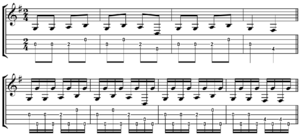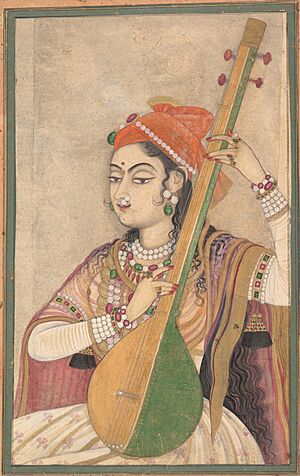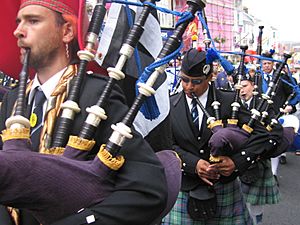Drone (sound) facts for kids
In music, a drone is a special sound effect. It's like a continuous, steady note or chord that plays throughout most of a song. Think of it as a background sound that never stops.
A drone can also be a part of a musical instrument that makes this continuous sound. For example, the long pipes on a bagpipe are called "drone pipes." An old word for a drone was burden. Sometimes, a "burden" also meant a part of a song that repeats, like a refrain or chorus.
Contents
What Does a Drone Do in Music?
A drone is one of the simplest but most powerful musical ideas. It can be made by holding a sound for a long time or by repeating a note over and over.
Drones often help set the main musical "feel" or tonality of a piece. This means they create a base sound that the rest of the music builds upon. Drones can be played by instruments, sung by voices, or both! They can be low, high, or in the middle of the music.
Often, a drone is played on the main note of a song (the tonic) or the second most important note (the dominant). When a drone is on the same pitch as a melody note, it can make that note stand out more.
A drone is similar to a pedal point, but a drone usually lasts longer. A pedal point might need to change or "resolve" into another sound, but a drone can just keep going.
Where Do Drones Come From?
The idea of using drones started a long time ago in the music of ancient Southwest Asia. From there, it spread to Europe and Africa.
Drones are very important in Indian music. Instruments like the tanpura, ektar, and shankh (a conch shell) are used to create these continuous sounds.
Many types of bagpipes around the world have drone pipes. This is why bagpipes are often one of the first instruments people think of when they hear about drone music. In America, some banjos, which were influenced by African music, have a special drone string.
Since the 1960s, drones have also become a big part of drone music and other kinds of avant-garde music, which means experimental or new music.
Drones are also common in traditional singing, especially in Europe and some parts of Asia and the Pacific islands.
Drone Parts of Instruments
When we talk about a "drone" as part of an instrument, we mean the part that makes the continuous sound without the player needing to focus on it all the time.
Many Indian instruments, like the sitar and sarod, have special strings that act as drones. For example, a sitar has three or four strings that vibrate to create a drone sound.
Bagpipes, such as the Great Highland Bagpipe, have several drone pipes that give them their unique sound. A hurdy-gurdy also has one or more drone strings.
The fifth string on a five-string banjo is a drone string. It has its own tuning peg and is usually not pressed down by the player's fingers. The Crwth, an old Welsh instrument, also has two drone strings.

Drones in Famous Music
Composers of Western classical music sometimes use drones. They do this to create a feeling of old times or a country setting, like in Scottish folk music.
Here are some examples:
- Haydn used a drone in the finale of his London Symphony.
- Beethoven used drones in his "Pastoral" Symphony.
- Wagner's opera Das Rheingold starts with a long, low drone played by horns and other instruments.
- Mahler used a seven-octave drone in the beginning of his Symphony No. 1 to sound like nature waking up.
- Bartók used drones in his piano music based on folk songs.
Modern composers also use drones a lot. Composers like Arvo Pärt and John Tavener use them in their music, which is often inspired by old church chants. The continuous single notes in minimalism music, like that of La Monte Young, are also a type of drone.
Drones are still common in folk music. Early songs by Bob Dylan, like "Masters of War" and "Mr. Tambourine Man", use a guitar tuned to create a drone effect. The song "You Will Be My Ain True Love" from the movie Cold Mountain also uses a drone bass.
Drones are also found in blues music and genres that came from the blues. The rock band U2 often uses drones in their songs. In the Led Zeppelin song "In The Light", a keyboard drone plays throughout the song.
Drones for Learning Music
Drones are used in many music education programs. They help students train their ears and improve their sense of pitch. They can also help musicians learn to play together without a lot of practice.
A shruti box is an instrument often used by singers for this kind of musical training. Because of their steady sound, drones can help create interesting musical structures that are different from typical melodies and harmonies.
See also
 In Spanish: Pedal (música) para niños
In Spanish: Pedal (música) para niños
- Drone metal - a type of heavy metal music that uses a lot of long, low, droning sounds from guitars and bass.
- Jivari



